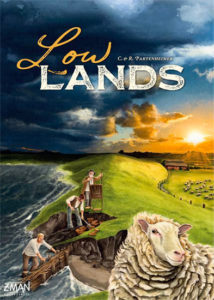 When looking at the box and reading the copy, you would be tempted to put Lowlands on the “Suffering European Peasants” shelf next to Agricola, or the “Scottish Economy” shelf next to Clans of Caledonia. A game about sheep farming in the Scottish Lowlands, with the ever-present threat of flooding from the rising tide, Lowlands builds an experience where players have to balance the needs of their own farm and flock against the requirements of working towards the greater good of all. Does Lowlands succeed? Spoiler alert: YES.
When looking at the box and reading the copy, you would be tempted to put Lowlands on the “Suffering European Peasants” shelf next to Agricola, or the “Scottish Economy” shelf next to Clans of Caledonia. A game about sheep farming in the Scottish Lowlands, with the ever-present threat of flooding from the rising tide, Lowlands builds an experience where players have to balance the needs of their own farm and flock against the requirements of working towards the greater good of all. Does Lowlands succeed? Spoiler alert: YES.
Lowlands is an action selection and resource management game for 2-4 players, that plays between one and two hours. Lowlands plays well at all player counts.
Gameplay Overview:
Lowlands is divided into three stages, each with two alternating sets of work and upkeep phases, followed by a high-tide cleanup phase. During each phase, flood cards will be revealed showing how much the water level rises, represented by wooden flood pieces that get placed and stacked as the stages advance.
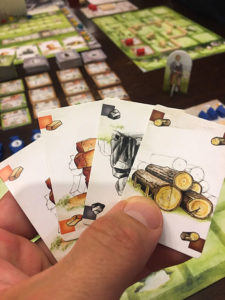
The main action of the game occurs during the work phases, where players use their farmers to pick the actions they want to take. Each farmer has a point value (2, 3 or 4 points respectively) in the resolution of that action. The possible actions are described below:
- Gain resources: Cards are drawn for each action point available. There are three types of resources – wood, clay, and stone.
- Contribute to the dike: Resources are spent to move up on the construction track and a dike segment is built when progress reaches the end of the track. The higher the dike gets, the smaller the segments become, meaning more contributions are necessary as the game proceeds. You also earn points for contributing to the dike.
- Build and/or move fences: Fences are built by spending the same type of resources and action points or moved by spending action points. Fences are used to enclose areas where sheep can be housed.
- Buy and sell sheep: The sheep market has a limited capacity for sheep, limiting the number that can be bought and sold per phase. Sheep value fluctuates throughout the game based on the success or failure of dike construction.
- Build farm expansions: Buildings and farm features can be selected from a tableau and built by spending resources. Each building or feature has its own unique power, such as immediately gaining money per sheep, being able to store more sheep in a fenced-in area, or scoring bonus points at the end of the game. Each farm can hold four buildings.
The upkeep phase is where all the bookkeeping occurs. As players build fences and buildings, they uncover more income-generating icons which provide them with more resources and money during upkeep. Sheep then breed and the market resets.
During the high-tide phase, the height of the flood tokens is compared to the height of the dam. If the dike holds, then players who contributed to the dike receives bonus money based on their comparative contributions. However, if the flood waters rise above the dike level, the players who contributed the least are punished by losing sheep at the end of play. The value of sheep and dike points then shifts (depending on success or failure) and the next cycle of work/upkeep/high tide begins. After three such cycles, the end of the game is reached. The player with the highest number of points, based on number of sheep, money, bonus points and dike points is declared the winner.
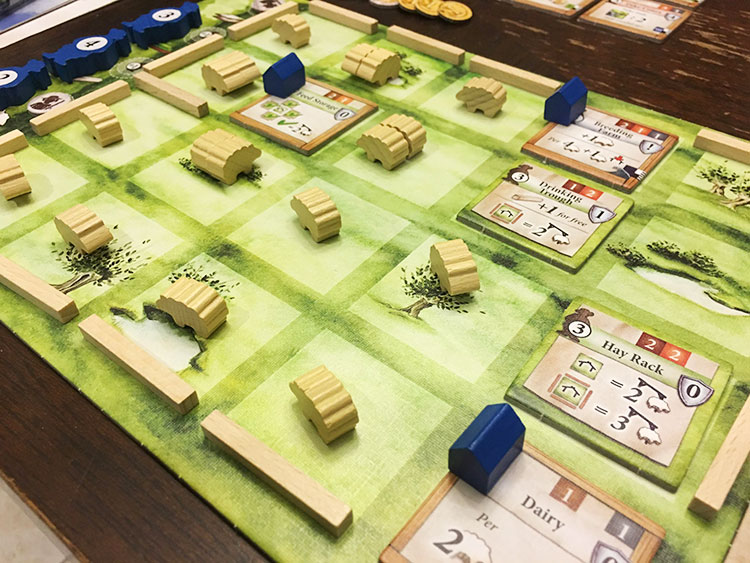
Game Experience:
Lowlands asks quite a bit of people who play – build your flock of sheep, build the dike, and construct the best buildings and features. Did you do the math yet and realize that you need to get all that done by using only 18 actions? Once you get past the first phase or so, the tension that Lowlands generates so expertly begins to set in, and this tension is what drives the game and makes it such an enjoyable (if somewhat exhausting) experience.
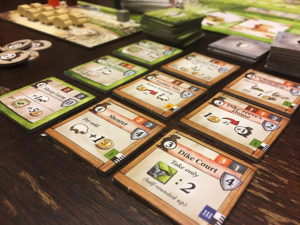
While playing, it is easy to get locked in on your own farm, worrying about only your next actions and strategy, because there is no competition with the other players for action spaces (like in Agricola). However, the tension that Lowlands generates is ratcheted up because you have to always be eyeing your opponents’ actions. If you think a player is going to be building the dike, maybe you can get away with taking another action, but it could come back to haunt you later on.
Surprisingly enough, you would think that this is a complicated game to teach and learn. On the contrary, we found that (aside from some technical minutiae about a few buildings) the game is taught in about 15 minutes. Mind you, actual strategy took quite a few plays to figure out, but the fact that such a complicated game can hit the table running like this only adds to its quality.
As keeping with the idea of generating tension, Lowlands is designed cleverly as to not allow you to lock in to one strategy, requiring you to be flexible and adaptive to the actions of your opponents and to the variability of the game. Going all-in on dike building or sheep farming could put you into an early lead, but focusing on only one aspect of gameplay is not the route to victory. Where the tension comes in is deciding when to focus more on farm or dike construction.
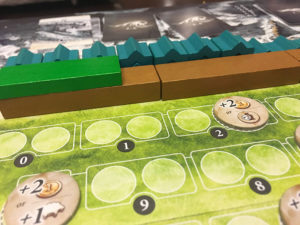
One of the best mechanics of the game is during dike construction, when a player is required to ask another player if they want to assist in building. This one moment can potentially lead to a amount of analysis. Do you ask the lead player, giving them the opportunity to earn more points, but knowing that they’ll be able to add to construction, which is what you are hoping? Do you ask a player, knowing that they will refuse? One small and simple mechanic of asking another player for help adds a whole layer of cost/benefit analysis that only adds to the enjoyment of the game.
Most components are not worth mentioning in the game experience, but it is worth noting that the design of the flood and dike tiles are absolutely outstanding and truly add to the game experience. The dread that you get when you see the flood tokens pile up and the satisfaction you get in dropping down dike segments do a great job of immersing you in the theme, and the developers deserve kudos for such an amazing job. Unfortunately, the only negative we could find was that we would have liked a better solution for the farmer meeples than a sticker with the action point value printed on them – it is a bit visually jarring.
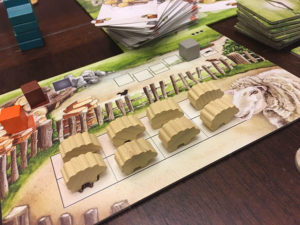
While Lowlands has obvious comparisons to Agricola (not surprising considering Uwe Rosenberg assisted in development), the games are not at all alike. Lowlands, arguably, generates even more tension than Agricola does because of its even more limited number of actions and continual need to change strategies. However, it is not surprising that we find both of these titles quite enjoyable.
Final Thoughts:
Lowlands is an outstanding game, with deep layers of strategy and tension that last from start to finish. Excellent components, surprisingly easy rules to learn, and tight gameplay make Lowlands a game that is worthy of adding to your shelf.
Final Score: 5 Stars – Amazing. On my list for Game of the Year, no doubt.
 Hits:
Hits:
• Deep, analytical gameplay
• Amazing components
• Not multiplayer solitaire – you need to keep tabs on your opponents
Misses:
• Stickers on worker meeples could have had a better solution










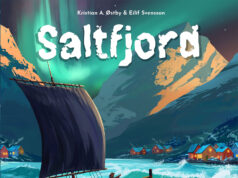













Great review. The more I hear about this game and the intricate decision making, the more I’m interested. The high price is keeping me from getting it right away but I’m hoping for a good sale in the next couple of months to get it! Also, I posted your review on the game’s 5CC page to hopefully get you some more exposure. https://www.5colorcombo.com/search/game/KyiRI2i7Ep Thanks for the in depth review!
Netherlands. Lowlanders who love tulips
Not Scotland. Highlanders who love hagis.
They are both wet and dreary, fine. But geography and socially completely different.
I have to comment on your pics: really clear and detailed. Some of the best pics I’ve seen on any board game review site. I’ve given up on finding the game in English, however. I’m going to talk to some sellers about the French edition.